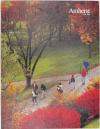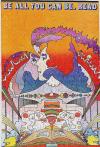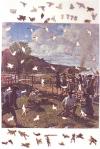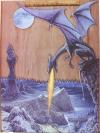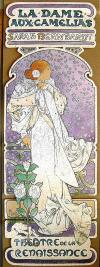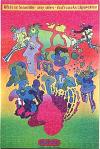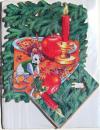Interest in jigsaw puzzles continued to decline after WW II and even the successful Pastime line offered by Parker Brothers since 1908 was closed in 1958. Interest in die cut cardboard puzzles flared in the mid-1960s with the introduction of Springbok puzzles but hand cut wood puzzles witnessed the "old-timers" from the 1930s dying and few new cutters entering the field. We commissioned two such cutters, Roland Chesley and Charles Russell, to cut 80 puzzles for us in the 1970’s. However, the past three decades have witnessed a resurgence of interest in wood puzzles ranging from fulltime professional makers such as Stave Puzzles and Elms Puzzles to various degrees of part-time and amateur makers, many of whom cut wonderful puzzles. The prices can also vary from 20 to 30 cents/piece to $2 to $3/piece. There are also wood puzzles being made by automated processes such as lasers and water jets, which generally run between 10 and 20 cents/piece. While modern puzzles are not our focus, we have picked up many in recent years (some given to us) and a few are displayed in this exhibition, including puzzles cut by our son, Conrad, and me.
I cut this photograph supplied by Amherst College for our 40th Class reunion in 1998. It was auctioned off for several hundred dollars, the proceeds going to the Alumni Fund. But the buyer never assembled it and return it to me. Extensive color line cutting with 10 figure pieces (including “1998” and “1958”). I have cut several puzzles over the years for my Amherst Class ’58 reunion auctions.
Peter Max print we had Roland Chesley cut into a puzzle in 1971. Interlocking with 4 figure pieces. Mr. & Mrs. Chesley, both in their 80’s, lived in an old Maine farm house with a cavernous barn where he cut puzzles summer and winter! Picture was used as a poster to promote a national reading campaign. Many of Max’s posters were used to promote worthy causes.
One of several prints of A. Lassell Riply paintings which my former employer, The Paul Revere Life Insurance Co., commissioned to celebrate the life and times of patriot Paul Revere. Pagey cut this one into a puzzle for us in 1993 in exchange for a puzzle cut by our son, Conrad. She employed some color line cutting with 34 figure pieces. Ms. Elliott was the finest designer and cutter of animal figure pieces in the world probably because she had studied, drawn and written books about the gaits of horses and dogs. The puzzle is displayed with the figure pieces removed to the side, a practice I don't normally follow but am making an exception here because of their unusual quality. Please note in the lower center the cutout figure of a dog howling over his fallen master, a fine example of a figure piece related to the scene. That was Ms. Elliott's genius (she is now deceased).
Cut by our son, Conrad, for the family but especially for his oldest brother, Scott, who was a keen fan of the Tolkien trilogy in his teens. Highly irregular edges designed to enhance as well as to emulate the flames of a hellish world. 10 appropriate figure pieces, 6 of which are large figures of dragons cut into multiple pieces. A truly spectacular scene, extremely difficult to assemble. Artist is unknown.
- This 3200 piece wood jigsaw puzzle was made for and presented to me in April 2007 by my puzzle colleagues in recognition of my contributions to the world of jigsaw puzzles. It was designed by Melinda Shebell, Stow, MA and individual sections were hand cut by 14 different puzzle makers from around the country, including our son, Conrad. I was stunned by the gift. This puzzle is special to me because it reflects much of my research and activities in the puzzle world the past 25 years.
- Scenes are 16 coaching scenes from novels of Charles Dickens painted by artist Albert Ludovici, Jr., and as prints and cut into puzzles around the 1912 centennial of Dickens’ birth. I have been collecting and promoting the puzzles since my retirement in 1995.
- Corner figures represent characters from Dickens’ novels. I am a long-time member and Treasurer of the Worcester Chapter of the Dickens Fellowship, London, England.
- Most cutting styles and 37 special cutting techniques (the unusual things not found in most puzzles) employed in the puzzle are based on my research and published articles, including 2-layered for a 3-D effect and 2-sided on five of the coaching scenes.
- Central image is Samuel Pickwick from Pickwick Papers, one of my favorite Dickens’ characters. It is designed to fit into a slot when puzzle lays flat and “pop up” (a special cutting technique). Pickwick carrying wine glass is a parody of me at puzzle meetings and open houses I have organized over the years as I greet attendees at Friday’s social hour.
- “RAA” (my initials) and “April 13, 2007” (date puzzle was presented to me) are cut into sections immediately to the left and right of center section.
- 5 poorly made replacement pieces were inserted into puzzle when presented to me in anticipation that I would spot them and start thinking about making better replacements. Only later was I presented with the original pieces (puzzle now displayed with originals). Joke well played on me!
- Frame was designed with puzzle piece motif and built by Joe Seymour, one of my puzzle colleagues, to allow puzzle to be displayed from both sides (several sections have pictures on both sides).
- Puzzle Box is covered with labels of the 14 puzzle makers contributing to puzzle.
Certainly, Full of the Dickens is one of the greatest puzzles ever made. More detailed account of the story and many features of this extraordinary puzzle may be found on the Full of the Dickens page.
In the 1930's, puzzle makers spent little time selecting artwork or planning how to cut the puzzle. Today, many makers such as Melinda Shebell who cut this extraordinary puzzle, spend much of their time searching for and selecting artwork, designing their figure pieces, planning their cuts and choosing a cutting style most appropriate for the picture. The results are superb puzzles such as this one: 9 complex enhanced figure pieces in the shape of camellias (note title), 10 elaborate scrolls, and color line cutting within the puzzle and along the irregular outline of the picture border. In this case, the result is also a very difficult puzzle to assemble. Artist is Mucha.
I cut this photograph supplied by Amherst College for our 40th Class reunion in 1998. It was auctioned off for several hundred dollars, the proceeds going to the Alumni Fund. But the buyer never assembled it and eventually return it to me. Extensive color line cutting with 10 figure pieces (including “1998” and “1958”). I have cut several puzzles over the years for my Amherst Class ’58 reunion auctions which my classmates bid up knowing the proceeds would go to the Alumni Fund..
Stave Puzzles of Norwich, VT first developed in the 1970's the technique of cutting multiple small "holes" within a puzzle to deceive the assembler, and even has its artists create artwork which is conducive for this and other special techniques. The display puzzle is an excellent example of the technique and special art. The puzzle also is cut around the color lines of the individual elves which require precise placement to fit in. Several figure pieces include "Bob" and "1995" (puzzle was a retirement gift from my office), and the Stave clown signature piece. Artist: Louise Koenig.
My Christmas gift to Hildegard in 1991. Cut partially along color lines with 6 figure pieces, deceptive dropouts, irregular edges. Stave designed the artwork so that the mouse appears to be putting a piece into a mirror image picture of the scene the mouse is in. The junction between the 2 scenes is the true "trick" in this puzzle. The piece the mouse is holding is the Stave signature piece but does not fit into the dropout-figure in the second scene as it looks like it should. A lovely fun challenging puzzle! Artist: E. Binsham.
While the Armstrong family has always loved wood puzzles, serious involvement began in 1990 when our son Conrad and I began to cut new puzzles. Puzzle pictured here was cut by me in 1991 out of a large poster advertising a Mozart opera festival. I "revised" the scene by cutting out Mozart’s hand and opera names from other sections of poster and laying them on top of the central image and "double cutting" them to fit into central section as if Mozart's hand were writing the score just above the opera names. Areas dropped out of central section are shown alongside of puzzle with area shaped like the hand left uncut. Puzzle can be assembled and displayed in several different ways. However, faced with Conrad’s clearly superior cutting skills (see example displayed and on Conrad’s web site at: www.newpuzzles.com), I shifted my focus to restoration, collection, study, sale, presentation and display of old puzzles, and only cut occasionally for selected charitable causes.
A collage of scenes and information relating to WW II made by Mandolin Puzzles, London, England 1986c. Can you find the theater or battle you or someone in your family served in during WW II? For me, it was my father in two theaters of action illustrated in the puzzle. Artist is Paul Wright.
Wonderful artwork by John Frederick Lewis who helped create a vogue for oriental art in the mid-19th century. Well cut by Sarah White, a leading British cutter in the late 20th century with 12 figure pieces and extensive color line cutting.
